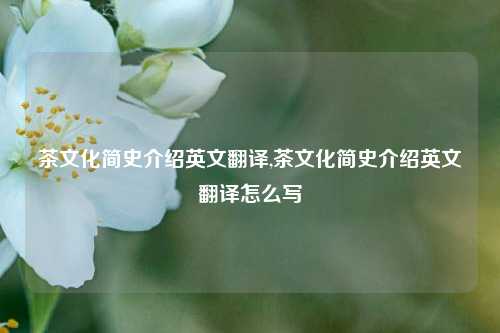 摘要:
如果你在茶文化简史介绍英文翻译中迷失了方向,茶文化简史介绍英文翻译可能是你的指南针。让我们一起来看看它如何引领潮流。Title: The History and Culture...
摘要:
如果你在茶文化简史介绍英文翻译中迷失了方向,茶文化简史介绍英文翻译可能是你的指南针。让我们一起来看看它如何引领潮流。Title: The History and Culture... 如果你在茶文化简史介绍英文翻译中迷失了方向,茶文化简史介绍英文翻译可能是你的指南针。让我们一起来看看它如何引领潮流。
Title: The History and Culture of Fujian Tea: An IntroductionChina, with its rich history and diverse culture, has long been known for its tea culture. Fujian, a province on the southeastern coast, is one of the main regions in China for tea production, with its unique climate and soil conditions favoring the growth of high-quality tea plants. This article will explore the history and culture of Fujian tea, focusing on its production, varieties, and influence on Chinese tea culture.Tea has been cultivated in Fujian for over 3,000 years, with evidence of tea leaves and tea seeds discovered in archaeological sites dating back to the Shang Dynasty (16th-11th century BC). During the Qin Dynasty (221-206 BC), tea was already recognized as an important cultural symbol of China, with tea ceremonies becoming a popular way to foster social relationships and promote harmony.The production of Fujian tea begins with the planting of tea plants in suitable soil and climate conditions. The process includes harvesting the tea leaves, processing them into different forms (such as green, white, oolong, and black tea), and finally marketing the tea to consumers. Fujian's unique climate and soil conditions favor the growth of high-quality tea leaves, which are then processed into various types of tea, including Keemun, Wulong, Longjing (Lotus Tea), and Baiyun (White Cloud Tea).Fujian's tea culture is deeply influenced by its unique history and cultural background. The region's farmers have developed various techniques for processing tea leaves into different flavors and textures, while also incorporating local customs and beliefs into their tea ceremonies. These ceremonies are often held in private homes or public places, with participants drinking tea while discussing important issues such as politics, economics, and culture.Fujian tea has also had a significant influence on Chinese tea culture. Its unique varieties and high-quality production have made Fujian tea a highly prized commodity among Chinese tea enthusiasts. Fujianese tea masters have also left a lasting legacy in the art of tea preparation, passing down their skills and knowledge to subsequent generations.In modern times, Fujianese tea has become a popular export item, with many types of Fujianese tea being exported to other countries around the world. This has not only brought economic benefits to Fujianese farmers but also promoted the understanding and appreciation of Chinese tea culture among foreigners.In conclusion, Fujian, with its rich history and unique climate and soil conditions, is known for its production of high-quality tea. Its unique tea culture, influenced by its history and culture, has left a lasting legacy in Chinese tea culture. Today, Fujianese tea has become a highly prized commodity both domestically and internationally, not only bringing economic benefits to the region but also promoting the understanding and appreciation of Chinese tea culture to a wider audience.。
希望这篇文章能激发你对茶文化简史介绍英文翻译的兴趣。记住,好东西总是值得等待的,但好机会不等人哦!









